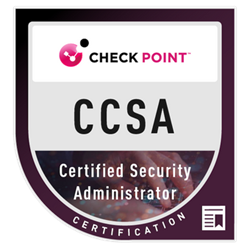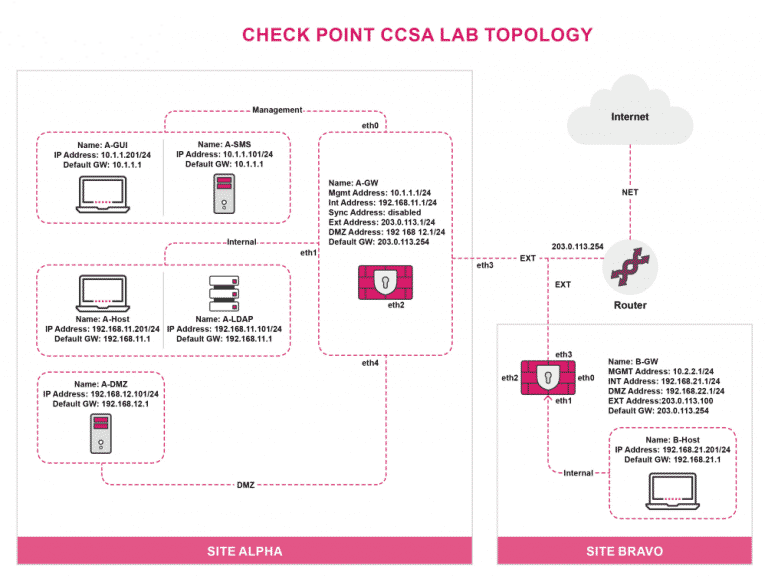Obiettivi | Certificazione | Contenuti | Tipologia | Prerequisiti | Durata e Frequenza | Docenti | Modalità di Iscrizione | Calendario

Il Corso Check Point Security Administration (CCSA) fornisce le competenze e le conoscenze dei concetti fondamentali necessari per configurare le tecnologie principali offerte dall’ecosistema Check Point. Durante il corso, i partecipanti apprenderanno come implementare, configurare e gestire una soluzione di sicurezza Check Point per proteggere le reti da minacce informatiche. Il corso copre una vasta gamma di argomenti, tra cui l’installazione e la configurazione del software Check Point, la gestione degli utenti e degli oggetti di sicurezza, la configurazione del controllo degli accessi, la configurazione delle regole di sicurezza, la gestione delle connessioni VPN e molto altro. Il corso contribuisce alla preparazione dell’esame di Certificazione Check Point Security Administrator (CCSA).
Sintesi Statistica :
- Corsi realizzati: 31;
- Numero Corsisti: 128;
- Superamento Esame: 93,80%
Contattaci ora per ricevere tutti i dettagli e per richiedere, senza alcun impegno, di parlare direttamente con uno dei nostri Docenti (Clicca qui)
oppure chiamaci subito al nostro Numero Verde (800-177596)
Obiettivi del corso
Di seguito una sintesi degli obiettivi principali del Corso Check Point CCSA Security Administrator:
- Installazione e configurazione del software Check Point per la sicurezza di rete.
- Gestione efficace degli utenti e degli oggetti di sicurezza in ambienti Check Point.
- Configurazione dettagliata del controllo degli accessi e delle regole di sicurezza.
- Approfondimento sulla gestione delle connessioni VPN e strategie contro le minacce informatiche.
- Esplorazione delle funzionalità avanzate di Check Point per la protezione delle reti aziendali.
Certificazione del corso
Esame Check Point Security Administrator (CCSA); Questo esame è una valutazione rigorosa, destinata a candidati che desiderano dimostrare la loro competenza nelle tecnologie e nelle pratiche di sicurezza Check Point. Questo esame testa la conoscenza approfondita dei partecipanti in vari aspetti chiave della sicurezza informatica, con un focus particolare sulle soluzioni Check Point. I candidati sono valutati sulla loro abilità di configurare e gestire la sicurezza di rete utilizzando il software Check Point, inclusa l’installazione e la configurazione di firewall e VPN. Altri argomenti cruciali includono la gestione degli utenti e degli oggetti di sicurezza, la configurazione delle regole di sicurezza e del controllo degli accessi, nonché la capacità di identificare e rispondere a minacce informatiche. Superare questo esame conferma che il candidato possiede le competenze necessarie per amministrare efficacemente le soluzioni di sicurezza Check Point in un ambiente professionale.
Contenuti del corso
- Describe the primary components of a Check Point Three-Tier Architecture and explain how they work together in the Check Point environment.
- Explain how communication is secured and how traffic is routed in the Check Point environment.
- Describe the basic functions of the Gaia operating system.
- Identify the basic workflow to install Security Management Server and Security Gateway for a single-domain solution.
- Create SmartConsole objects that correspond to the organization’s topology for use in policies and rules.
- Identify the tools available to manage Check Point licenses and contracts, including their purpose and use.
- Identify features and capabilities that enhance the configuration and management of the Security Policy.
- Explain how policy layers affect traffic inspection.
- Articulate how Network Address Translation affects traffic.
- Describe how to configure manual and automatic Network Address Translation (NAT).
- Demonstrate an understanding of Application Control & URL Filtering and Autonomous Threat Prevention capabilities and how to configure these solutions to meet an organization’s security requirements.
- Articulate how pre-shared keys and certificates can be configured to authenticate with third-party and externally managed VPN Gateways.
- Describe how to analyze and interpret VPN tunnel traffic.
- Configure logging parameters.
- Use predefined and custom queries to filter log results.
- Identify how to monitor the health of supported Check Point hardware using the Gaia Portal and the command line.
- Describe the different methods for backing up Check Point system information and discuss best practices and recommendations for each method.
Attività Laboratoriali
- Deploying SmartConsole
- Installing a Security Management Server
- Installing a Security Gateway
- Configuring Objects in SmartConsole
- Establishing Secure Internal Communication
- Managing Administrator Access
- Managing Licenses
- Creating a Security Policy
- Configuring Order Layers
- Configuring a Shared Inline Layer
- Configuring NAT
- Integrating Security with a Unified Policy
- Elevating Security with Autonomous Threat Prevention
- Configuring a Locally Managed Site-to-Site VPN
- Elevating Traffic View
- Monitoring System States
- Maintaining the Security Environment
Tipologia
Corso di Formazione con Docente
Docenti
I docenti sono Istruttori Autorizzati Check Point e in altre tecnologie IT, con anni di esperienza pratica nel settore e nella Formazione.
Infrastruttura laboratoriale
Per tutte le tipologie di erogazione, il Corsista può accedere alle attrezzature e ai sistemi presenti nei Nostri laboratori o direttamente presso i data center del Vendor o dei suoi provider autorizzati in modalità remota h24. Ogni partecipante dispone di un accesso per implementare le varie configurazioni avendo così un riscontro pratico e immediato della teoria affrontata. Ecco di seguito alcuni scenari tratti dalle attività laboratoriali:

Dettagli del corso
Prerequisiti
I partecipanti dovranno avere una conoscenza basilare dei fondamenti del Networking e della sistemi Windows/Linux.
Durata del corso
- Durata Intensiva 3gg;
Frequenza
Varie tipologie di Frequenza Estensiva ed Intensiva.
Date del corso
- Corso Check Point CCSA (Formula Intensiva) – 09/09/2024 – 09:00 – 17:00
Modalità di iscrizione
Le iscrizioni sono a numero chiuso per garantire ai tutti i partecipanti un servizio eccellente.
L’iscrizione avviene richiedendo di essere contattati dal seguente Link, o contattando la sede al numero verde 800-177596 o inviando una richiesta all’email [email protected].


